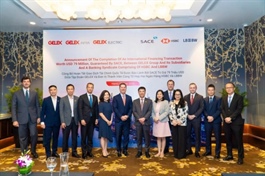Smaller businesses the focal point of CIT law amendments
Smaller businesses the focal point of CIT law amendments
Hundreds of thousands of smaller enterprises in Vietnam are set to benefit from a reduction in corporate income tax from next year, meaning more opportunities to improve their competitiveness.
The amendments to the Law on Corporate Income Tax (CIT), set to be adopted on June 13, were scrutinised at the National Assembly last week after careful preparations by the Ministry of Finance and government discussions.

A cut in CIT would mean crucial savings for some smaller companies |
The amendments, set to be valid from 2026, aim to help remove difficulties for business performance and ensure stability of state budget revenues.
One of the biggest highlights in the draft amendments is that it has embraced some new specific policies, such as the supplementation of regulations for the application of lower CIT for micro, small, and medium-sized enterprises, at 17 and 15 per cent, respectively.
Under Article 10 of the draft, the CIT common tax rate is 20 per cent. However, a rate of 15 per cent shall be applied to enterprises with total annual revenue not exceeding VND3 billion ($120,000), and a rate of 17 per cent shall be applied to those with total annual revenue from over VND3 billion ($120,000) to not exceeding VND50 billion ($2 million).
“The revenue used as the basis for determining enterprises eligible for the CIT rates of 17 and 15 per cent is the total revenue of the immediately preceding CIT period,” Article 10 said. “In the case of newly established enterprises, the government shall provide detailed regulations on determining the total revenue used as the basis for application.”
Under the Law on Support for Small- and Medium-sized Enterprises, small enterprises refer to those with 10-49 employees, and total annual revenue and capital of VND50 billion ($2 million) and VND20 billion ($800,000), respectively. Micro-sized enterprises refer to those with from 1-9 employees, and total annual revenue and capital of VND3 billion ($120,000).
Vietnam’s corporate tax environment is structured to support both domestic and foreign enterprises, and all taxes are imposed at the national level. The standard CIT rate is 20 per cent. Enterprises operating in the oil and gas industry are subject to CIT rates ranging 25-50 per cent, depending on each contract.
Enterprises engaging in prospecting, exploration, and exploitation of certain mineral resources are subject to a CIT rate of 50 per cent.
Vietnam is now home to about nearly one million enterprises, with the vast majority being smaller companies that are often cash-strapped and lack output markets, with weak competitiveness.
Figures from the National Statistics Office showed that in 2024, just over 100,000 businesses halted operations, up 12.4 per cent as compared to the previous year. Nearly 76,200 enterprises stopped operations and waited for dissolution procedures, up 16.3 per cent; and more than 21,600 enterprises completed such procedures.
The first four months of 2024 saw over 68,700 businesses with suspended operations, up 13 per cent on-year; nearly 20,200 businesses stopped operations, up 5.7 per cent; and over 7,600 enterprises completed dissolution procedures, up 26.1 per cent. On average, more than 24,000 businesses left the market each month.
Nguyen Thi Son, vice director of Cong Bang Foodstuff Co., Ltd. based on the outskirts of Hanoi, told VIR that her company is faced with massive difficulties.
“Prices of input materials like sugar, gas, beans, and cooking oil have increased by an average 13 per cent since late last year, while we still have to pay many types of taxes, including a CIT rate of 20 per cent costing about $1,000 per month,” said Son, whose company employs 30 people.
“If the CIT is reduced to 17 per cent, we can save about $350 a year. The sum is not big, but it is a testament to the state’s support to small-sized enterprises like us,” Son said.
However, according to Nguyen Thi Tuat, director of agricultural company Hoang Ngoc Trading JSC in Hanoi, there is an urgent need to lower assorted taxes for businesses that are more vulnerable to shocks in the market. “For example, a CIT reduction could be offered to those with total revenue of below VND10 billion ($400,000) a year and this should be divided into different levels for application,” Tuat said.
|
When it comes to the criteria for enterprises to be subject to a tax rate of 15 or 17 per cent, according to the current Law on Support for Small- and Medium-sized Enterprises, there are many criteria to determine the type of enterprise, and enterprises are divided according to the field of operation. According to these criteria, the number of micro- or small-sized companies accounts for nearly 94 per cent of the total number today. Thus, if these criteria are used to determine the beneficiaries of incentives, almost all enterprises today are eligible for preferential CIT rates, leading to a situation of widespread incentives, not really achieving the goal of prioritising support for enterprises in need of incentives. That’s why the draft law has determined the preferential CIT rate of 15 or 17 per cent based on the revenue criterion, not on the criteria of such enterprises, to ensure compliance with the policy of encouraging and supporting enterprises. This aims to make it simple and convenient for tax authorities and enterprises to use existing revenue databases to identify beneficiaries of incentives. Source: National Assembly Standing Committee report on draft amendments to the Law on Corporate Income Tax |
- 10:16 30/05/2025




























